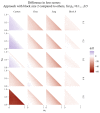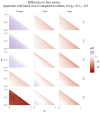A stochastically curtailed two-arm randomised phase II trial design for binary outcomes
- PMID: 32860470
- PMCID: PMC7612167
- DOI: 10.1002/pst.2067
A stochastically curtailed two-arm randomised phase II trial design for binary outcomes
Abstract
Randomised controlled trials are considered the gold standard in trial design. However, phase II oncology trials with a binary outcome are often single-arm. Although a number of reasons exist for choosing a single-arm trial, the primary reason is that single-arm designs require fewer participants than their randomised equivalents. Therefore, the development of novel methodology that makes randomised designs more efficient is of value to the trials community. This article introduces a randomised two-arm binary outcome trial design that includes stochastic curtailment (SC), allowing for the possibility of stopping a trial before the final conclusions are known with certainty. In addition to SC, the proposed design involves the use of a randomised block design, which allows investigators to control the number of interim analyses. This approach is compared with existing designs that also use early stopping, through the use of a loss function comprised of a weighted sum of design characteristics. Comparisons are also made using an example from a real trial. The comparisons show that for many possible loss functions, the proposed design is superior to existing designs. Further, the proposed design may be more practical, by allowing a flexible number of interim analyses. One existing design produces superior design realisations when the anticipated response rate is low. However, when using this design, the probability of rejecting the null hypothesis is sensitive to misspecification of the null response rate. Therefore, when considering randomised designs in phase II, we recommend the proposed approach be preferred over other sequential designs.
Keywords: adaptive design; cancer; continuous monitoring; interim analysis; oncology.
© 2020 The Authors. Pharmaceutical Statistics published by John Wiley & Sons Ltd.
Conflict of interest statement
The authors declare no potential conflicts of interest.
Figures





References
Publication types
MeSH terms
Grants and funding
LinkOut - more resources
Full Text Sources
Medical

